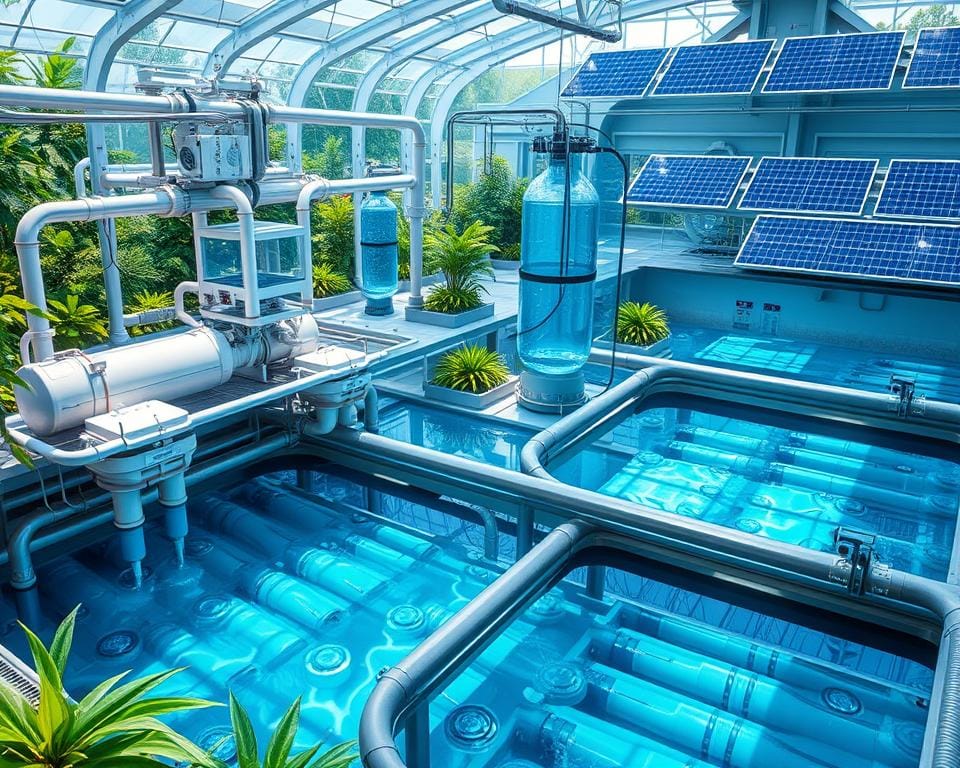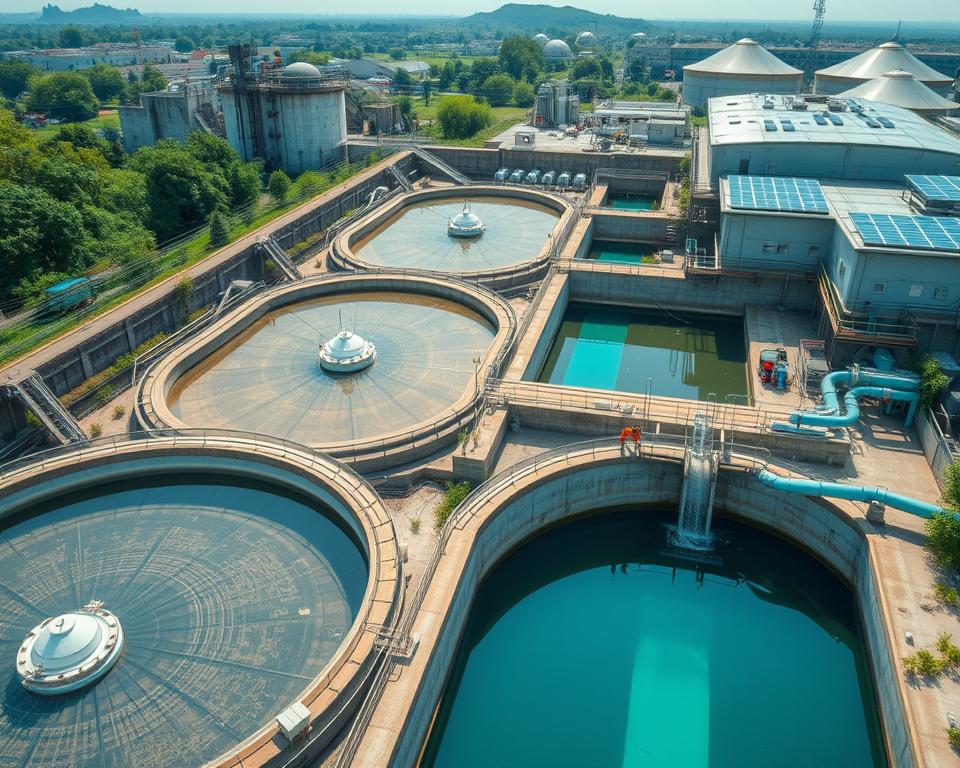Modern water treatment plants are key in keeping water resources safe and sustainable. This is especially true in cities and industrial areas. These advanced facilities make sure that cleaning water meets strict public health and environmental rules. They remove up to 99% of harmful materials from water.
The first step, or primary treatment, filters out big solids, oils, and dirt from the water. Then, during secondary treatment, bacteria in activated sludge tanks break down contaminants. In the tertiary treatment phase, chemicals like chlorine are used. This kills any remaining bacteria and pathogens, making water safe for us and the environment.
But water treatment is more than just a series of steps. It’s about preserving natural water cycles and promoting sustainable use of water. With the growing concern for water scarcity and climate change, these plants’ role is crucial. They ensure the water returned to nature doesn’t harm the ecosystem or local water sources.
The Importance of Water Treatment Plants
Water treatment plants are key to giving us clean water. They make sure our water is safe for drinking and helps keep the environment healthy. By cleaning wastewater, they stop diseases from spreading. They also keep pollution from harming our natural water sources.

The Role in Public Health
These plants work to meet EPA rules. They remove bad stuff from water, like germs and pollutants. This makes sure our drinking water is safe. Keeping water clean helps us stay healthy and protects nature too. For more info, check out water treatment systems.
Environmental Impact
Water treatment plants help our planet in big ways. They let industries work better and save money by providing consistent water quality. Using cleaned wastewater for things like farming is now more common. This helps fight water shortages and keeps our ecosystems going strong. To learn about water appliance standards, read here.
These plants are also tackling challenges from more people and bigger industries. They use advanced tech to catch tiny contaminants. Techniques like adding chlorine kill harmful microbes. With smart maintenance and monitoring, water plants run smoothly and keep our water safe.
Stages of Water Treatment
The water treatment process has several steps. Each one targets different pollutants. This ensures our water is clean and safe.
These steps are important for meeting health and environmental rules. We’ll explore the primary, secondary, and tertiary stages next.
Primary Treatment
The first step is primary treatment. It removes big particles using physical methods. Sedimentation is a key part of this, where heavier bits sink to the bottom.
First, screens catch large debris. Then, in tanks, solids settle and are removed as sludge.
Secondary Treatment
The next phase is secondary treatment. It breaks down organic matter with biology. Aerating the water helps bacteria grow, which eat pollutants.
This phase uses different techniques to enhance the breakdown of organics. It’s also vital for removing harmful nutrients to protect waterways.
Tertiary Treatment
Tertiary treatment further purifies the water. It makes sure the water follows strict rules. This stage uses advanced methods like disinfection and extra filtration.
It involves removing tiny particles and dissolving stuff. The aim is to refine the water, making it ready for use or return to the environment.
After these steps, the water gets final touches. Things like adjusting pH or adding fluoride make it suitable for us to drink.
Key Technologies in Modern Water Treatment Plants
Modern water treatment plants use advanced technology to purify water efficiently and effectively. We’re going to look at some of the important technologies they use.

Screening and Sedimentation
Screening and sedimentation are the first steps in treating water. Screening gets rid of large debris, making sure nothing blocks later processes. Through sedimentation, particles settle at the bottom for easy removal. These steps prepare for more complex technologies.
Biological Treatment Processes
Biological methods are very important for removing pollutants and nutrients from waste water. Technologies like BNR and MBRs have changed wastewater treatment. For example, BioFiltro’s system can clear up to 99% of contaminants in four hours. This helps a lot with water sustainability. MBBR technologies also improve treatment and lower greenhouse gas emissions.
Here are some advanced biological treatment processes:
- BioFiltro: Cuts greenhouse gas emissions by 91%, makes worm castings, and boosts crop yield.
- Aquacycl’s BETT system: Deals with high BOD wastewater and cuts greenhouse gases by 90%.
- Gross-Wen Technologies: Uses algae to get nutrients and make slow-releasing fertilizers.
Filtration Techniques
Filtration is crucial in water technology. Microfiltration and ultrafiltration filter out small particles and microorganisms. This keeps the water safe. MBRs add biological treatment to membrane filtration for even better results. For instance, Epic Cleantec can recycle up to 95% of a building’s water. This shows a big commitment to water sustainability.
The table below shows how effective different filtration methods are:
| Filtration Technique | Effectiveness | Applications |
|---|---|---|
| Microfiltration | Removes particles >0.1 micrometers | Initial filtration stages, water pre-treatment |
| Ultrafiltration | Removes particles >0.01 micrometers | Advanced water purification, pathogen removal |
| Membrane Bioreactors (MBRs) | Combines biological and physical filtration | Comprehensive wastewater treatment, high-quality effluent |
Advanced water technologies are key in modern plants. They make sure our water is managed well and sustainably.
The Role of Automation in Water Treatment
Water treatment automation has greatly improved how we clean water, making operations efficient and consistent. By using programmable logic controllers (PLC programming) and SCADA systems, water treatment has become more precise. This means better control at every stage of cleaning water.
Programmable Logic Controllers (PLCs)
PLCs play a vital role in automating water treatment. They handle important tasks like adding chemicals, controlling bacteria, and adjusting water flow. With smart PLC programming, treatment plants work better, use fewer chemicals, and save energy. This cuts costs and improves efficiency in a big way.
SCADA Systems
SCADA systems are key to monitoring water treatment closely. They gather data from sensors and devices, making it easy for operators to see. With SCADA, decisions can be made quickly to keep everything running right. This ensures plants meet rules and keep working without interruptions.
Monitoring and Maintenance
The data from SCADA systems means continuous checking of how equipment performs. Spotting problems early, this allows for quick fixes, avoiding expensive repairs. It makes sure plants run smoothly with less need for manual checks. This gives operators more time to make treatment processes even better.
Challenges and Solutions in Modern Water Treatment Facilities
Today’s water treatment plants have lots of challenges. These include fighting bacteria and using energy wisely. To keep our water safe and make sure these places last, we must find smart ways to solve these problems. It’s crucial to stop bacteria and use energy better to succeed.
Bacterial Control
Stopping bacteria is key for keeping water safe. This is why water plants focus so much on fighting bacteria. By using automated systems like Programmable Logic Controllers (PLCs), plants can stay at the right settings to stop bacteria from growing. This technology keeps the cleaning process strong and protects us from harmful germs.
Regular checks and repairs, helped by PLCs, are also important. They prevent leaks and other problems in old pipes and systems. This is how we keep our water safe from contamination.
Energy Efficiency
Using energy smartly is another big challenge for water plants. It’s important to use less energy without spending too much money. Many plants are now using sun power and high-efficiency machines to lower their energy use. This helps our planet and makes sure plants can support our needs even when things change.
Smart water-saving tools and low-water-use fixtures also help save energy. They make the whole system use less water and energy. This is good for both the planet and the water treatment process.
By trying these new methods, plants are not just solving today’s issues. They are also getting ready for the future. Moving forward with better, energy-saving technology ensures that everyone has enough clean water. For more info on keeping water safe and other smart solutions, check out this link on preventative measures for homes too.

